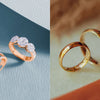
Gypsy Setting Diamond Ring: Unveiling Timeless Elegance
When you're exploring engagement ring styles, you might come across the term "gypsy setting," which refers to a distinctive and secure way of mounting gemstones into a ring. Unlike the typical prong settings you often see, a gypsy setting has the stone flush with the surface of the metal, providing a sleek and smooth exterior. This type of setting not only protects the diamond from external knocks but also contributes to a unique aesthetic that's quite different from traditional settings.
Table Of Contents
- History and Evolution of the Gypsy Setting
- Understanding the Gypsy Setting
- Types of Gypsy Set Rings
- Material and Gemstone Considerations
- The Durability of Gypsy Settings
- Comparing Gypsy Settings with Other Styles
- Pros and Cons of Gypsy Set Diamond Rings
- Selecting the Perfect Gypsy Set Engagement Ring
- Styling and Pairing with Wedding Bands
- Customization Options for Gypsy Setting Rings
- Frequently Asked Questions
The gypsy setting is particularly popular for men's rings due to its understated design and durability, but it has also started to be a fashionable choice for engagement rings for anyone seeking a blend of elegance and practicality. Your diamond is skillfully embedded into the band, making it less likely to catch on clothing and reducing the risk of damage. This kind of setting emphasizes the metal's craftsmanship as much as the stone itself, offering a harmonious balance between the two.
As engagement rings symbolize a lifelong commitment, choosing a gypsy setting can be a testament to a lasting bond, with its robust build representing the strength and endurance of the relationship. If you are drawn to the idea of a ring that merges minimalist beauty with functional design, a gypsy setting diamond ring might align perfectly with your preferences.
History and Evolution of the Gypsy Setting
As you explore the unique charm of gypsy set rings, you'll find that their journey from the Victorian period to today's contemporary styles is marked by subtle elegance and a departure from traditional engagement ring designs.
Origins in the Victorian Era
The gypsy setting originated in the Victorian era, a time characterized by ornate fashion and meticulous craftsmanship. This style emerged as a favorite for its ability to secure gemstones flush with the band, offering a smooth, snag-free surface. Unlike the raised profiles of typical antique rings, the gypsy setting incorporated the stones directly into the thick band of the ring, creating a seamless look indicative of the period's aesthetic.
Transition to Modern Influence
Shifting forward into the modern era, the gypsy set ring has evolved, adopting a contemporary style that often symbolizes a rebellious concept compared to standard ring settings. Today, it appeals to those seeking a blend of vintage allure and modern minimalism. The once traditional design has been reinterpreted with cleaner lines and a more minimalist setting, aligning with the sleek and straightforward trends of contemporary jewelry.
Understanding the Gypsy Setting
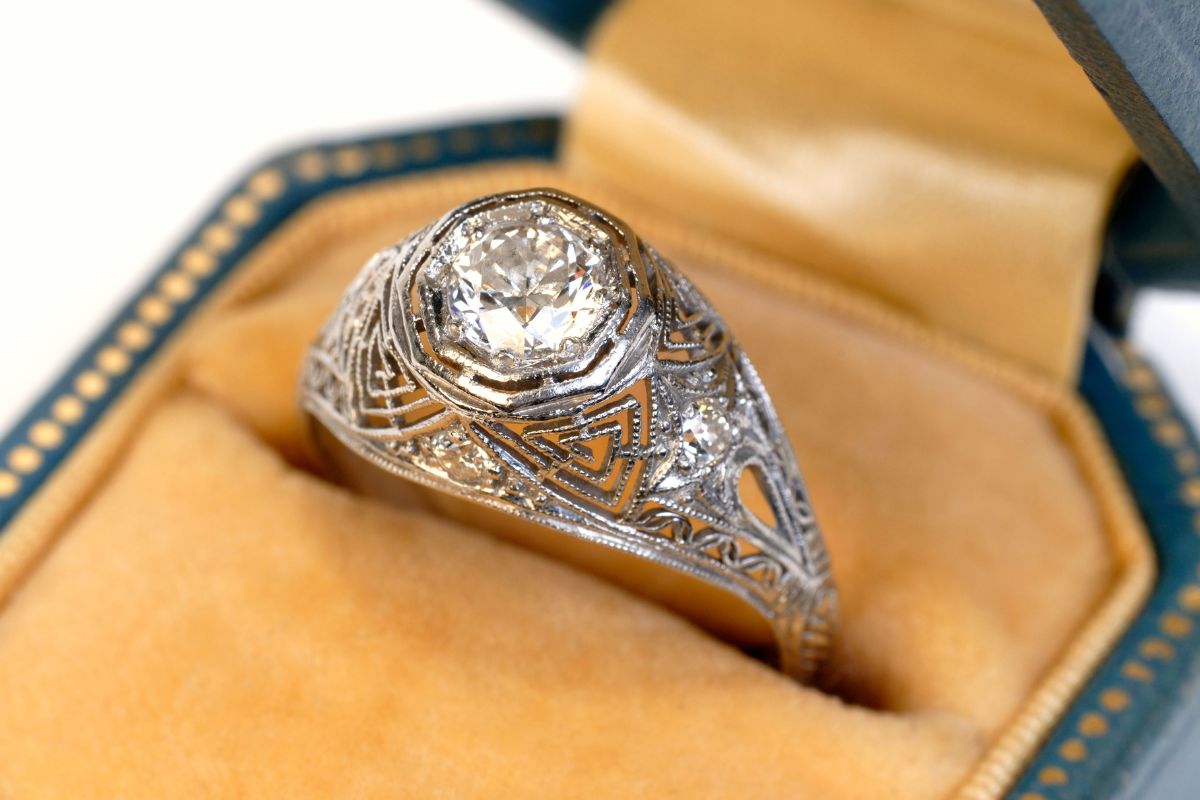
In the realm of jewelry, the gypsy setting stands out for its distinctive design that secures the diamond flush with the metal band. Employing a minimalist style, it allows for a seamless integration of the stone within the band, resulting in a smooth and clean appearance.
Design Characteristics
Your gypsy setting ring embodies a minimalist style that's both elegant and functional. The defining feature of this design is the way the diamond is encased within the metal band, creating a sleek, flush appearance. Unlike more traditional settings that may elevate the diamond above the band, the gypsy setting keeps the stone level with the surface, offering a clean and streamlined look.
The bands in a gypsy setting are often thick and rounded, which allows for the diamond to be fully enclosed within the material. The gypsy setting is adept at showcasing the stone in a flush mount setting, making it well-suited for an active lifestyle where a snag-free and robust design is paramount. The aesthetic is unmistakably modern, with a minimalist touch that highlights the diamond without unnecessary adornment.
Gypsy Setting Technique
When crafting a gypsy setting, jewelers typically begin with a metal band that is slightly tapered to complement the size and shape of the diamond. Your diamond is carefully placed in a drilled hole that matches its dimensions. The jeweler then uses a burnishing tool to smoothly extend the metal over the diamond's edges, securing it into place.
The flush setting technique requires precision as the diamond must sit level with the metal band's surface. The setting process may employ a hammer setting method, where the jeweler gently taps the metal over the stone, reinforcing the hold. This method ensures that the diamond remains firmly fixed within the band, reflecting a union of form and function, providing both aesthetic appeal and practicality.
Types of Gypsy Set Rings
Cushion Cut Yellow Moissanite Engagement Ring
Gypsy set rings are cherished for their sleek design and the way they secure gems. The setting style typifies a look where stones are set flush with the metal, offering a smooth surface.
Single Stone Rings
When you opt for a Single Stone Ring, the focus is on a solitary diamond that sits flush within a band, often complemented by the metal's polish and heft. The gypsy setting enhances the sparkle and brilliance of the center diamond, granting it a robust and seamless appearance. Single stone variants often feature a small stone, but can also showcase a larger diamond to create a striking star or sun-like effect on your finger.
Multi-Stone Variants
In Multi-Stone Variants of gypsy set rings, multiple diamonds or gems join the central stone. A popular choice is the three-stone ring, which might feature smaller accent diamonds alongside the center diamond to amplify the ring's overall sparkle. These rings artfully combine the subtlety of the gypsy setting with the allure of multiple stones, offering a tasteful balance between understated elegance and conspicuous charm.
Material and Gemstone Considerations
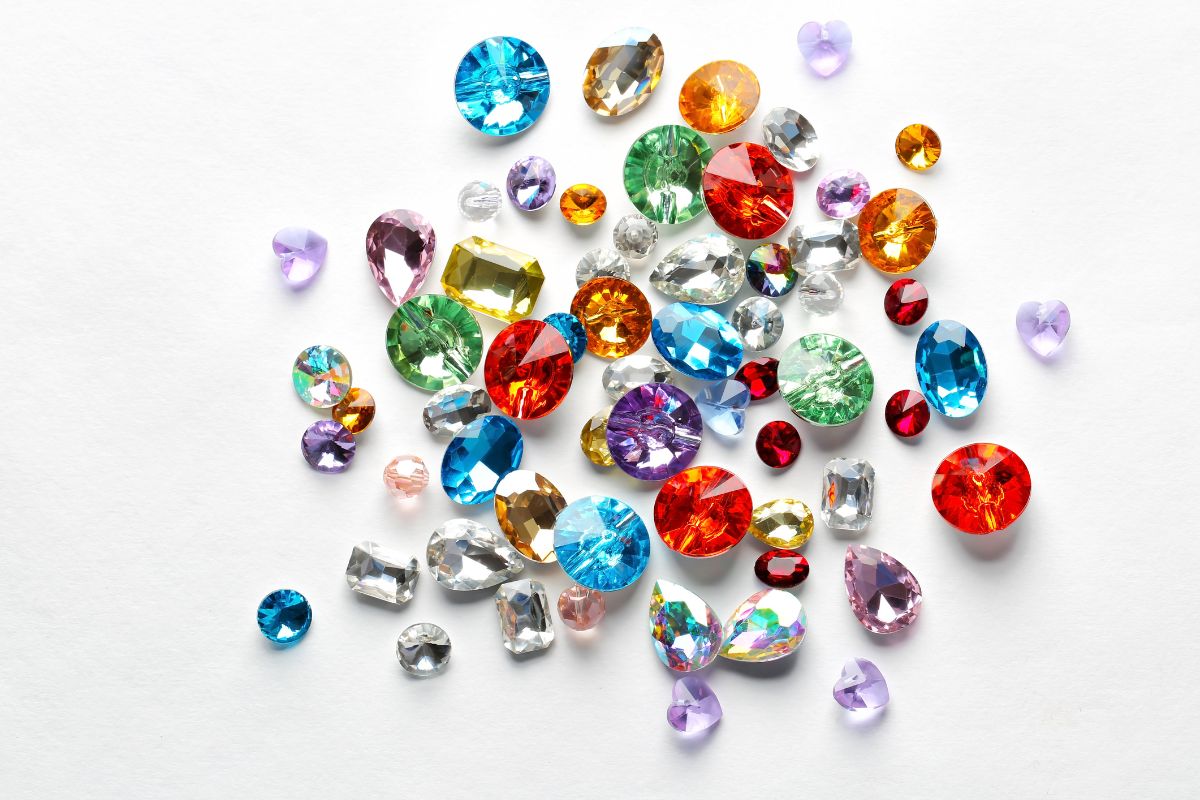
In choosing materials for a gypsy setting diamond ring, your priority should be to pair the right metal with suitable gemstones to ensure durability and security without compromising on quality or appearance.
Choosing the Right Metal
When selecting a metal for your gypsy setting ring, consider not only aesthetics but also the functionality and security of the setting. Yellow gold, historically a popular choice, offers a classic look and generally provides a softer setting which may be suitable for a gypsy ring. However, if you're looking for enhanced durability and a more secure setting, platinum is a superior choice. It's a dense, sturdy metal that holds gemstones firmly in place.
- Yellow Gold: Classic appearance, softer metal
- Platinum: Durable, secure and maintains quality over time
Selecting Gemstones
Your choice of gemstone is equally important in a gypsy setting. Since the stone is flush with the surrounding metal, not all gemstones are appropriate. More durable stones, such as sapphires and rubies, are advisable because they are harder and can withstand everyday wear and tear. Softer stones like emeralds run the risk of being damaged over time due to their brittle nature.
- Sapphires/Rubies: Highly durable, good for everyday wear
- Emeralds: More prone to damage, require careful wearing and maintenance
With the gemstone embedded into the metal, the gypsy setting ring reduces the risk of snagging and provides a smooth surface, which is why your selection should focus on stones that can handle the occasional bump or scrape without losing their luster.
The Durability of Gypsy Settings
Gypsy settings in diamond rings are reputed for their durability and strength, making them a suitable option for those who lead an active lifestyle. They are designed with everyday wear in mind, ensuring that your diamond stays secure even during vigorous activities.
Active Lifestyle Compatibility
When it comes to withstanding the rigors of an active lifestyle, a gypsy setting offers robust protection for your diamond. The stone is flush-mounted, sitting directly in the metal band, with the ring's material encasing the edges of the diamond. This sturdy construction means fewer snagging incidents and reduced risk of the diamond getting dislodged.
-
Pros:
- Reduced snagging
- Diamond protection
-
Cons:
- Limited visibility of the stone from the side
If you frequently engage in sports or physical work, the gypsy setting presents an advantageous choice.
Maintenance and Care
The maintenance of a gypsy setting is low-key, but routine care will extend the longevity of your ring’s sparkle and structure. Since the diamond is embedded within the band, it's less exposed to dirt and debris, keeping it cleaner for longer periods.
Here are key points to keep in mind for care:
- Regularly clean the metal around the stone to maintain its shine and to prevent the buildup of oils or grime.
- Inspect your ring periodically to ensure that the surrounding metal has not worn down; this can lead to loosening of the stone.
Although repairs are seldom needed with such a durable setting, it's crucial to have a jeweler check the ring if you notice any changes. As with any fine jewelry, treating your gypsy-set ring with care will preserve its condition over time.
Comparing Gypsy Settings with Other Styles
| Aspect | Gypsy Setting | Comparison Setting 1 | Comparison Setting 2 |
|---|---|---|---|
| 1. Setting Placement | Flush with the surface of the metal, with the gemstone set into a drilled hole. | Prong Setting | Pave Setting |
| 2. Security | Secure and protective, less prone to snagging due to the flush setting. | Secure but may have exposed edges. | Secure but may have multiple small prongs holding stones. |
| 3. Aesthetics | Minimalistic and sleek, showcasing the gemstone with a smooth, continuous surface. | Showcases the gemstone prominently with visible prongs. | Creates a dazzling, paved appearance with multiple small stones set closely together. |
| 4. Maintenance | Low maintenance, with fewer nooks and crannies for dirt or debris to accumulate. | Requires occasional prong checks and cleaning. | May require more frequent cleaning due to the close arrangement of stones. |
| 5. Durability | Durable due to the protected setting, ideal for those with an active lifestyle. | Durable but prongs may be more exposed to potential damage. | Durable, but individual small stones may be more prone to damage. |
| 6. Gemstone Visibility | High visibility with the gemstone sitting flush against the metal surface. | High visibility with the gemstone held prominently by prongs. | High visibility with multiple stones creating a sparkling surface. |
| 7. Suitability | Suitable for those who prefer a minimalist and protective setting. | Suitable for traditionalists who appreciate the classic look of prong settings. | Suitable for those who love a dazzling, intricate appearance with multiple stones. |
When you explore the world of diamond ring settings, you'll notice the distinct way gypsy settings secure the gemstone compared to more common styles. This section will detail how the gypsy setting contrasts with prong, bezel, flush, channel, and pavé settings in terms of style, sparkle, and visibility.
Gypsy vs. Prong Setting
- Style: The gypsy setting is characterized by its sleek surface, with the diamond set into the metal, creating a smooth finish. This is in contrast to the prong setting, where metal prongs extend above the band's plane to hold the stone in place.
- Sparkle and Visibility: Prong settings offer maximum visibility and allow more light to pass through the diamond, enhancing its sparkle. Gypsy settings may slightly reduce sparkle due to the stone being set deeper into the band.
Gypsy vs. Bezel and Flush Settings
Gypsy vs. Bezel Setting:
- Style: Similar to the gypsy setting, the bezel setting encircles the diamond with metal, protecting its edges. Unlike the gypsy setting, the bezel has a raised rim that wraps around the stone's perimeter.
- Visibility: While both styles offer good protection, the bezel setting can sometimes make a diamond appear larger due to its encompassing rim, but may also cover more of the stone than a gypsy setting.
Gypsy vs. Flush Setting:
- Style: The flush setting, like the gypsy, has a diamond set into the band, flush with the metal surface. However, gypsy settings often have a more pronounced metal presence around the diamond.
- Visibility: Both settings are less prone to snagging and provide a modern look, but gypsy settings can obscure the sides of the diamond slightly more than flush settings.
Gypsy vs. Channel and Pavé Settings
Gypsy vs. Channel Setting:
- Style: A channel setting secures diamonds within a channel made in the band with two strips of metal. This differs from the gypsy setting, which does not use channels but rather incorporates the diamond directly into the band.
- Visibility and Sparkle: Channel settings align stones side by side, offering greater visibility and consistent sparkle across multiple diamonds, unlike the singular focus of most gypsy settings.
Gypsy vs. Pavé Setting:
- Style: The pavé setting involves embedding multiple small diamonds close together on the band's surface, held by small prongs or beads. In comparison, a gypsy setting typically features a solitary stone, presenting a cleaner, less-adorned band.
- Visibility and Sparkle: Pavé settings are designed for maximum brilliance due to the multitude of stones. Gypsy settings offer a more subtle sparkle and can be ideal if you prefer understated elegance.
Pros and Cons of Gypsy Set Diamond Rings
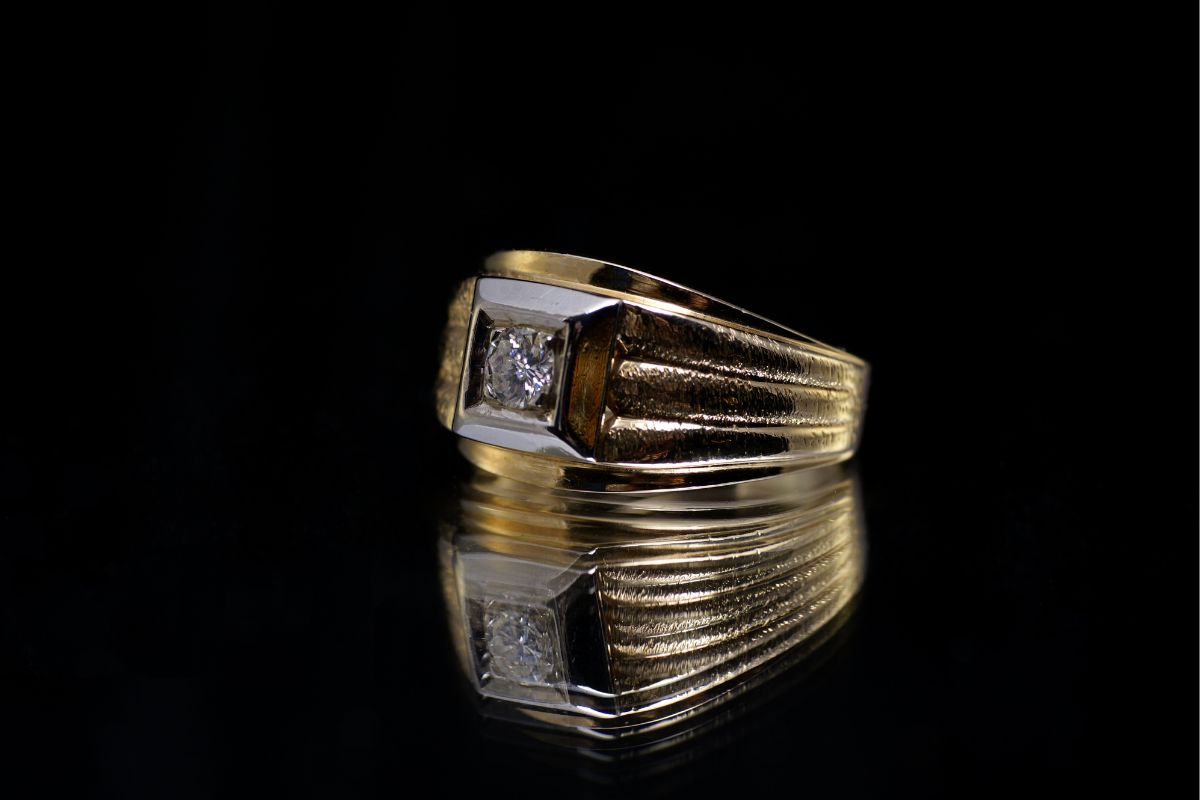
When considering a gypsy set diamond ring, it's essential to weigh the unique setting's benefits against its potential drawbacks to make an informed choice.
Advantages of Gypsy Setting
Durability: The gypsy setting offers enhanced security for your diamond, as it sits flush with the metal, protecting the stone from knocks and bumps. This characteristic makes it an excellent choice for your active lifestyle or if you work with your hands often. The protection provided to the edges of the stone helps prevent chips and cracks, potentially extending the life of your ring.
Clean Design: A gypsy set diamond ring boasts a sleek and clean design, as it lacks prongs and does not accumulate as much dirt or debris. This means you can maintain the cleanliness of your ring with minimal effort, and it's less likely to snag on clothing or hair.
Disadvantages to Consider
- Visibility and Sparkle: One of the disadvantages to consider is that a gypsy setting can limit the visibility of your diamond. Because the stone is set into the band, less light can enter from the sides, which might reduce the sparkle that makes a diamond so desirable. For someone seeking maximum brilliance and shine, this may not be the ideal setting.
- Small Stone Limitation: If you opt for a gypsy setting, be mindful that it may not be well-suited for very small stones. Smaller diamonds can appear lost within the band, making them challenging to see and appreciate. If your heart is set on a delicate, petite diamond, you might want to consider alternative settings that can better highlight a smaller stone’s beauty.
Selecting the Perfect Gypsy Set Engagement Ring
When choosing a gypsy set engagement ring, meticulous attention to the quality of gemstones, the robustness of the metal band, and the harmony between style and budget are paramount.
Assessing Quality and Craftsmanship
Evaluating the craftsmanship of a gypsy set engagement ring is essential. This setting involves flattening the metal’s surface and embedding the diamond into it, so it sits flush with the band, making the quality of workmanship critical to the ring's longevity. Check for a smooth finish around the gemstone and ensure the diamond is securely fastened, which will reduce the likelihood of it catching on fabrics.
Importance of Metal Band and Setting
The metal band plays a dual role in both the security of the diamond setting and the ring's overall aesthetic. Popular options include platinum, gold, and rose gold, each adding a distinctive look to the ring. Ensure the metal choice complements the diamond and aligns with your style preferences. For a gypsy setting, a thicker band is preferable as it offers more material to hold the gemstone in place.
Balancing Style and Budget
Marry your personal style with your budget by exploring various combinations of gemstones and metal bands. While diamonds are traditional, other gemstones can be equally splendid and more cost-effective for an engagement ring. Determine your finances upfront and prioritize elements like the quality of the diamond and the durability of the setting to find a compromise that maintains both elegance and fiscal responsibility.
Styling and Pairing with Wedding Bands
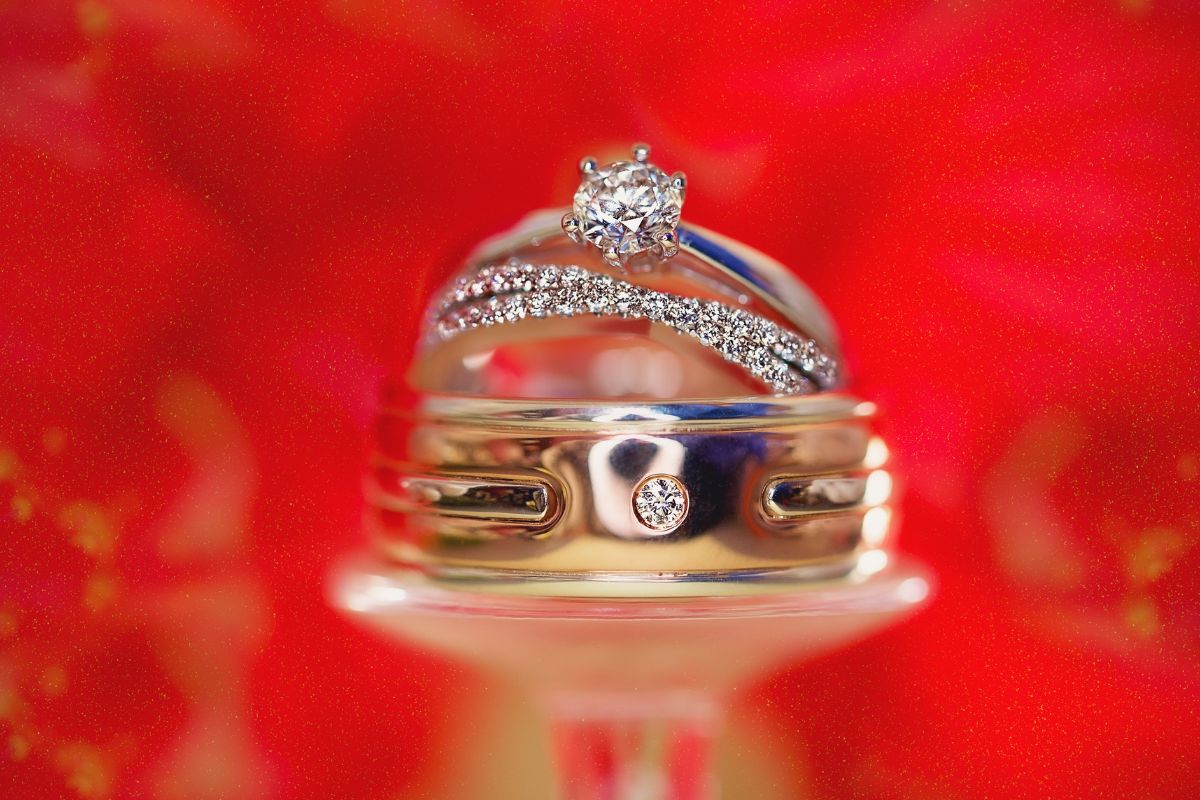
When selecting a wedding band to accompany your gypsy setting diamond ring, consider designs that enhance the ring's unique characteristics. Your gypsy set ring is versatile enough to pair with various wedding band styles, metal types, and matching sets that symbolize your union.
Complementary Wedding Band Designs
Opt for wedding bands that echo the contour and embellishment of your gypsy setting. Look for bands with engravings, millgrain edges, or pavé diamonds to harmonize with the bohemian flair. If your engagement ring features a substantial metal band, a slimmer wedding ring can provide balance without overpowering the set.
- Flush Fit: Ensures no gaps between engagement ring and band
- Curved or Notched Bands: Wrap around the engagement ring’s setting
Mixing Metal Types and Styles
Don't be afraid to mix metal types for a contemporary twist. A gypsy setting often features a robust gold or platinum band that can be elegantly contrasted with a wedding ring in a different metal, such as rose gold or white gold.
- Contrasting Colors: Yellow gold with white gold or platinum for a two-tone effect
- Same Metal, Different Finish: Matte, hammered, or high polish to differentiate
Matching Sets for Couples
For couples looking to express their connection through their rings, choose wedding bands that share a common design element with the gypsy set ring. One could select a metal band with textures or patterns that resonate with the engagement ring's details for a cohesive look.
- His and Hers Bands: Similarly styled bands to denote unity
- Complementary Textures: A textured men's band to match the rustic charm of a gypsy set ring
When styling and pairing wedding bands with your gypsy setting diamond ring, let your individuality and aesthetic preferences guide your choices to create a set that is both personal and harmonious.
Customization Options for Gypsy Setting Rings

When selecting your gypsy setting ring, you have a range of customization options that allow you to infuse personal style into your design. The gypsy setting, known for its sleek surface and stones flush with the band, can nonetheless be tailored to your aesthetic preferences.
- Metal Choices: Opt for traditional metals like gold and platinum or explore more modern options such as rose gold or palladium. Each brings a distinctive hue and durability to your ring.
- Stone Selection: Diamonds are classic, but you can also choose from sapphires, rubies, or other gemstones for a unique twist.
- Band Design: Customize the band with engravings or milgrain detailing along the edges for a vintage feel.
- Finish: A polished finish will give you a shiny, reflective surface, while a matte or brushed finish provides a subtler, more contemporary look.
Consider incorporating a signature design element that represents something personal, such as a birthstone hidden within the band or a special date engraved inside.
By exploring these facets of customization, your gypsy setting ring will not only be a statement of style but also a personalized emblem that's truly yours. Choose elements that resonate with your identity and taste to create a piece that stands out with understated elegance.
Also Read
Frequently Asked Questions
In this section, you'll find answers to common inquiries about gypsy set diamond rings, addressing their historical significance and unique characteristics.
What is the historical significance of the gypsy setting in rings?
The gypsy setting, also known as a flush mount setting, originated in the Victorian era. This technique was favored for its ability to provide a sleek and smooth finish to the rings, reflecting a minimalist aesthetic while ensuring the diamond's protection.
How can you identify a genuine vintage gypsy set diamond ring?
A genuine vintage gypsy set ring generally features a band that evenly surrounds the diamond, which is sunk into the metal to sit flush with the surface. Characteristics like older hallmarks, the cut of the diamond, and the patina of the metal can also be indicators of age.
What are the defining characteristics of a gypsy set ring?
A gypsy set ring is defined by its design where the diamond is flush with the surface of the metal band. There is no prong or bezel visibly holding the stone; instead, it is held securely within a drilled hole and the surrounding metal.
How does a gypsy setting ensure the security of the diamond?
The gypsy setting protects the diamond by having it sit within the band of the ring itself. The snug fit and lack of external prongs mean that the diamond is less susceptible to knocks and less likely to catch on clothing or other materials.
What variations exist in gypsy set diamond rings?
Variations in gypsy set diamond rings include different band widths, types of metal, and embedded stone shapes. Some rings feature intricate designs engraved into the band, while others maintain a stark, clean look.
How does a three-stone gypsy ring differ from other types?
A three-stone gypsy ring features a trio of diamonds set flush within the band, typically with the center stone being slightly larger than the side stones. This design symbolizes the past, present, and future, offering a deeper meaning compared to a single stone setting.
Checkout some of our top collections:
Leave a comment
Please note, comments must be approved before they are published.


